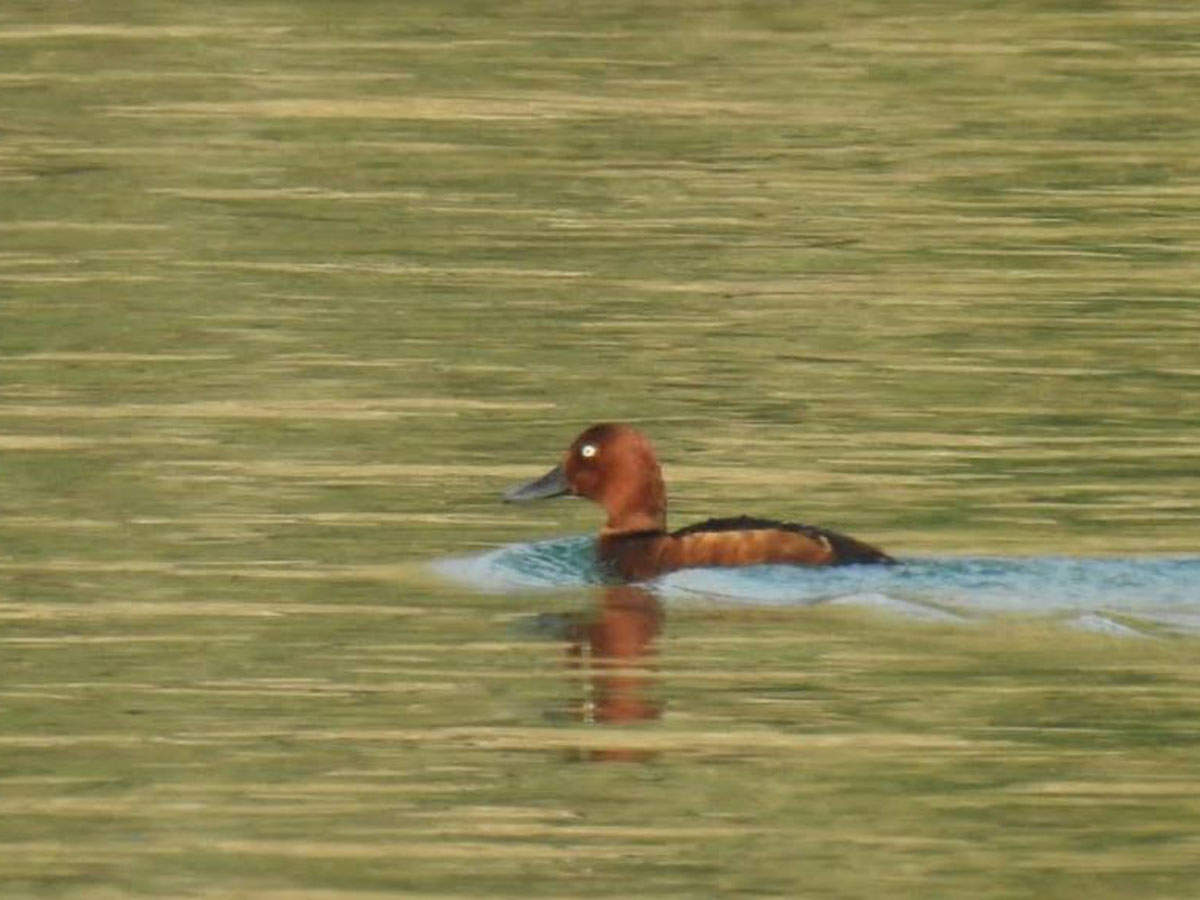Ecologist suggests improvement in the degrading habitat of Nangal Wildlife Sanctuary

CHANDIGARH : Ecologist and conservationist TK Roy who has been conducting different seasonal survey cum monitoring of bird species in the forest areas of Punjab for last five years took stock of breeding of residents birds in Nangal Wildlife Sanctuary in the Summer-Monsoon season recently. He noticed lesser number of shallow water birds and surprisingly one lone long-distance migratory and International Union Conservation Nature (IUCN) listed threatened water bird Ferruginous Duck which migrates from North Asia. Roy also pointed at the degrading condition of habitat and lack of sufficient nesting place for resident birds.
Roy is also member of Indian Bird Conservation Network, state coordinator of Wetlands International and member of IUCN Threatened Waterfowl Specialist Group.
Nangal WLS is a small protected area under the Wildlife Protection Act, 1972 in the district of Rupnagar. The water body , Nangal dam , in the sanctuary is surrounded by smaller forest patch , which has actually been a rich wildlife habitat especially for birdlife.
"Summer-monsoon is the prime breeding season of birdlife. With the support of Ropar Wildlife Division's conservation team, I recorded 60 birdlife diversity out of total 134 species recorded from 2014 till last year. This time, I found 56 resident species and four Indian resident summer migratory species as the larger numbers of long distant winter migratory water birds and terrestrial bird species have already migrated for breeding to their own resident habitats, “ said Roy adding that the 60 species include 16 species of water birds and 44 species of terrestrial birds out of which , three species are of summer migratory terrestrial birds (Indian Golden Oriole, Common Hawk Cuckoo and Blue-tailed Bee-eater) and only one species of summer migratory water bird (Lesser Whistling Duck).
In the time period between 2014 to 2018, he said that he recorded total 134 bird species diversity which includes 61 species of water and water dependent birds and 73 species of terrestrial birds (resident & migratory species). Around 90 species out of 134 have been Indian Schedule birds (Schedule I, IV & V) under the Wildlife Protection Act, 1972 and seven species of IUCN Red-listed Threatened species (NT, EN & VU category) which indicates richness of birdlife diversity of the sanctuary.
"Out of recorded 56 resident species during this time are mostly resident breeding birds and mostly among Indian Scheduled Species under the Wildlife Protection Act 1972 of the sanctuary and their successful breeding going on.
Very surprisingly, Ferruginous Duck still was found in the sanctuary wetland, may be incapable to fly back long distance due to some physical problem. If so the sanctuary authority must protect this single threatened bird for survival till the next winter,” Roy said.
He expressed concern over degrading habitat saying, “The marshland of the sanctuary is breeding habitat of some of the resident water birds but it is in drying condition for extreme hot climate. This could be most probably because of late monsoon rain and global climate change impact, which resulted into recording a few numbers of water birds for breeding such as as Purple Swamphen, Indian Moorhen, White-breasted Watergen, etc.”
He spotted a suitable but smaller breeding habitat with a few poplar trees and mainly tall ones in the middle of the dam (wetland) . These trees are now full of nesting colony of the other resident water bird species as Little Cormorants, Purple Herons, Cattle Egrets, Black-crowned Night Herons, Little Egrets. “The forest department must grow more tall trees to provide more nesting avenues for the birds. The addition of more trees will certainly improve the eco system of the area, “he added.
Among the resident terrestrial breeding bird species were Common Myna, Brahmini Starling, Asian Pied Starling, Jungle Myna, House Crows, Eurasian Colored Dove, etc. Those found breeding on the electricity poles and medium trees were Himalayan Bulbul, Red-vented Bulbul. Those who opted for tree holes were Rose-ringed Parakeet, Blossom-headed Parakeets, Coppersmith Barbets, Brown-headed Barbets, etc while Common Tailorbird, Ashy Prinia, Plain Prinia, Pied Bushchat, etc were breeding on the shrubs and reeds. Red-wattled Lapwing, Indain Peafowl, Grey Francolinm, etc are breeding on the ground. House Sparrow, Brown Rockchat, etc have taken on the common houses.
Roy is also member of Indian Bird Conservation Network, state coordinator of Wetlands International and member of IUCN Threatened Waterfowl Specialist Group.
Nangal WLS is a small protected area under the Wildlife Protection Act, 1972 in the district of Rupnagar. The water body , Nangal dam , in the sanctuary is surrounded by smaller forest patch , which has actually been a rich wildlife habitat especially for birdlife.
"Summer-monsoon is the prime breeding season of birdlife. With the support of Ropar Wildlife Division's conservation team, I recorded 60 birdlife diversity out of total 134 species recorded from 2014 till last year. This time, I found 56 resident species and four Indian resident summer migratory species as the larger numbers of long distant winter migratory water birds and terrestrial bird species have already migrated for breeding to their own resident habitats, “ said Roy adding that the 60 species include 16 species of water birds and 44 species of terrestrial birds out of which , three species are of summer migratory terrestrial birds (Indian Golden Oriole, Common Hawk Cuckoo and Blue-tailed Bee-eater) and only one species of summer migratory water bird (Lesser Whistling Duck).
In the time period between 2014 to 2018, he said that he recorded total 134 bird species diversity which includes 61 species of water and water dependent birds and 73 species of terrestrial birds (resident & migratory species). Around 90 species out of 134 have been Indian Schedule birds (Schedule I, IV & V) under the Wildlife Protection Act, 1972 and seven species of IUCN Red-listed Threatened species (NT, EN & VU category) which indicates richness of birdlife diversity of the sanctuary.
"Out of recorded 56 resident species during this time are mostly resident breeding birds and mostly among Indian Scheduled Species under the Wildlife Protection Act 1972 of the sanctuary and their successful breeding going on.
Very surprisingly, Ferruginous Duck still was found in the sanctuary wetland, may be incapable to fly back long distance due to some physical problem. If so the sanctuary authority must protect this single threatened bird for survival till the next winter,” Roy said.
He expressed concern over degrading habitat saying, “The marshland of the sanctuary is breeding habitat of some of the resident water birds but it is in drying condition for extreme hot climate. This could be most probably because of late monsoon rain and global climate change impact, which resulted into recording a few numbers of water birds for breeding such as as Purple Swamphen, Indian Moorhen, White-breasted Watergen, etc.”
He spotted a suitable but smaller breeding habitat with a few poplar trees and mainly tall ones in the middle of the dam (wetland) . These trees are now full of nesting colony of the other resident water bird species as Little Cormorants, Purple Herons, Cattle Egrets, Black-crowned Night Herons, Little Egrets. “The forest department must grow more tall trees to provide more nesting avenues for the birds. The addition of more trees will certainly improve the eco system of the area, “he added.
Among the resident terrestrial breeding bird species were Common Myna, Brahmini Starling, Asian Pied Starling, Jungle Myna, House Crows, Eurasian Colored Dove, etc. Those found breeding on the electricity poles and medium trees were Himalayan Bulbul, Red-vented Bulbul. Those who opted for tree holes were Rose-ringed Parakeet, Blossom-headed Parakeets, Coppersmith Barbets, Brown-headed Barbets, etc while Common Tailorbird, Ashy Prinia, Plain Prinia, Pied Bushchat, etc were breeding on the shrubs and reeds. Red-wattled Lapwing, Indain Peafowl, Grey Francolinm, etc are breeding on the ground. House Sparrow, Brown Rockchat, etc have taken on the common houses.
















All Comments ()+^ Back to Top
Refrain from posting comments that are obscene, defamatory or inflammatory, and do not indulge in personal attacks, name calling or inciting hatred against any community. Help us delete comments that do not follow these guidelines by marking them offensive. Let's work together to keep the conversation civil.
HIDE